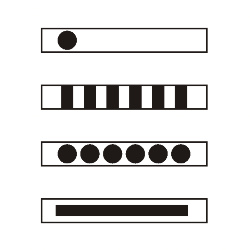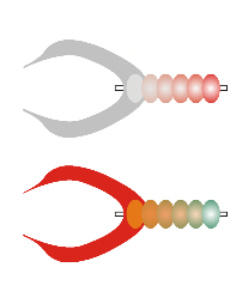General
According to tests and general observations in the nature,
pursuits of horizontally moving small objects, float up small objects and
sinking small objects are stereotypical motor acts in the feeding behaviour of
fish (Protasov, 1968). These motor acts as well as typical feeding poses play
an important signaling role in the intraspecific (like roach-roach) and
interspecific (like perch-roach) relationships. Furthermore, predatory fish
prefer to attack foraging prey over nonforaging ones and nose-down foraging
prey over horizontally foraging ones (Krause & Godin, 1996). The foregoing
patterns when evidently larger objects pursue horizontally moving, lifting and
sinking smaller objects can be imitated by two odd sized artificial lures,
using the well known lure slip, rise and fall retrieving technique.
For more information about odd sized lures, please read
Two
lures in tandem are much more effective than an integrated lure
Fishing Practice
In our
context, teasers are small (ranged from 2-3 mm to several centimeters) hookless
lures that are used with spinners, spoons, wobblers, jigs and other relatively
large lures. Small teasers are located at the main line ahead of the
main lure to simulate the foregoing odd object patterns. As for rigging,
sliding teasers, in particular, are strung directly on the line without knots
or loops that weaken the line. Teaser’s sliding along the line is restrained by 2-way swivel, with the attached leader (line, steel, fiber) and main lure,
or rear and front tightly sliding silicon stoppers.
Roundish Teasers
One large
bead of bright colors or 2, 3 and more smaller beads located at the main line
ahead of the main lure are powerful teasers that significantly increase the
number of bites this lure due to the foregoing effect. Spheric, oval and
cylindrical. Floating, suspending and sinking. Among teasers of this type, the
so called gogglers in the form of plastic or metallic roundish beads with the
bilateral notches to stick in 2D & 3D holographic eye-spots have an
impressive effectiveness.
Relatively
large silicon stoppers of eye catching colors also are good sliding teasers.
Tube Teasers
The very
usable tube teasers are made of hard plastic and metallic tubes of bright
colors without or with the additional decorations. Simple tubes of
white, red, copper, gold and silver colors as well as tubes wrapped with the
holographic foil are sufficiently effective. Fig.1 illustrates the dramatically effective tubes with eye-spots,
gratings, stripes and other the so called amimetic units.

Figure 1. Dramatically
effective tube teasers with the amimetic decorative units (read text)
For more information about amimetic units, please read
Tube
lures test
Visual
amimetic stimuli. An introduction
Vibrating Teasers
The modern
soft plastic materials allow to create sliding teasers with vibrating and
undulating adnexa, depending on their length, that are highly attractive. Fig.2
illustrates double curly tail "grubs” of small size (about 1″). Dancing
Eggs with tails, produced by Atlas Mike’s Bait Co., also are highly effective.
To extend the life of soft teasers, we recommend to paste in their bodies the
thin longitudinal plastic tubes, as it is made in the olivette weights used in
bobber fishing.

Figure 2.
Double curly tail grubs (scheme) with the internal thin plastic tubes for
sliding (read text)
Basic References
Krause J. Godin J-G.J. 1996. Influence of prey foraging posture
on flight behavior and predation risk: predators take advantage of unwary prey.
Behavioral Ecology 7, 264-271
Protasov V.R. 1968. Vision and near orientation in fishes.
Moscow, Science
...
Read more »





